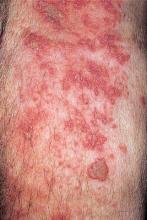The herpes zoster vaccine reduced the incidence of the disease by 55% in real-world clinical practice, according to a report in the Jan. 12 issue of JAMA.
This finding, from a retrospective cohort study involving more than 303,000 healthy, community-dwelling adults aged 60 and older from diverse backgrounds, confirms and extends the results of clinical trials that found the vaccine effective under idealized conditions. In addition, the cohort study found further benefits that had not been shown before: The herpes zoster vaccine also decreased the rate of ophthalmic herpes, and it was effective in patients with underlying chronic diseases that were feared to interfere with their immune function.
Thus, the benefits of the herpes zoster vaccine extend to the ophthalmic manifestation of the disease, to all races, both genders, and all ages over 60, as well as to patients with chronic illness, said Hung Fu Tseng, Ph.D., of Southern California Kaiser Permanente, Pasadena, and associates.
These results are particularly important given that the public's acceptance of the vaccine has been slow, and it is not yet in widespread use. "This vaccine has the potential to annually prevent tens of thousands of cases of herpes zoster and postherpetic neuralgia nationally. To date, herpes zoster vaccine uptake has been poor due to weaknesses in the adult vaccine infrastructure and also due to serious barriers to the vaccine among clinicians and patients.
"Solutions to these challenges need to be found so that individuals seeking to receive herpes zoster vaccine will be able to reduce their risk of experiencing this serious condition," Dr. Tseng and his colleagues wrote.
They assessed the vaccine's effectiveness in 75,761 California patients in the managed care plan who were immunized in 2007-2009, comparing outcomes with those of 227,283 age-matched control subjects who were not vaccinated. A total of 5,434 cases of herpes zoster developed during an average follow-up of 1-2 years.
The incidence of herpes zoster was 6.4 per 1,000 person-years in the vaccinated group, compared with 13 per 1,000 patient-years in the control group. This reflects a 55% reduction in incidence with the vaccine, the investigators wrote (JAMA 2011;305:160-6).
This result indicates that "1 episode of herpes zoster would be averted for every 71 patients receiving the vaccine," they wrote.
The vaccine benefit persisted across all subgroups of patients, particularly in the oldest subjects. "Our results support recommendations to offer herpes zoster vaccine to eligible patients of all ages, including the oldest population," Dr. Tseng and his associates wrote.
"For the oldest group, this could translate into a very large absolute reduction in disease because they bear the greatest burden of herpes zoster and postherpetic neuralgia and are also especially vulnerable to these disabling conditions," the researchers added.
The vaccine's effectiveness against ophthalmic herpes is an important finding not reported previously. Ophthalmic involvement is common and can lead to serious vision-threatening sequelae, they noted.
The finding that the vaccine also was effective in patients with chronic underlying disease was "reassuring," because "these diseases might have interfered with functional immunity and vaccine effectiveness. Control of pain from herpes zoster and postherpetic neuralgia is complicated in these patients because of their underlying conditions and the medications they must take," Dr. Tseng and his colleagues said.
The study was limited in that it involved only fully insured patients in a single region of the country, so "the results need to be generalized carefully." In addition, with its short follow-up, the study "was not designed to capture any decline in protection that is likely to occur with time," they added.
Dr. Tseng and three associates reported receiving research funding from Merck for other vaccine studies.


